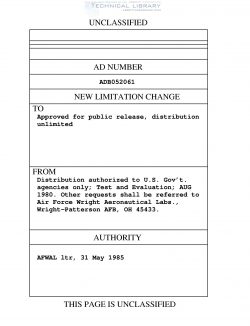AFML-TR-79-4221
- Version
- 199 Downloads
- 5.43 MB File Size
- 1 File Count
- March 1, 2017 Create Date
- March 1, 2017 Last Updated
High Temperature Windshield-Canopy Materials Development

This report covers the first year of work on the program to develop new. high temperature stable. transparent plastics for use in high perfomance aircraft as materials of construction for uindshields and/or canopies. Thirty novel materials were prepared during this period. each with a glass transition teak perature exceeding those of currently used acrylic and polycarbonate plastics. and possessing varying degrees of transparency. color. and impact strength. and polyesters has resulted in the more thermally stable materials. Depending upon the reactants involved, new polyesters, polycarbonates. polyester carbonates copolyesters and copolyester carbonates have been prepared. Materials based upon tetramethyl dicumyl bis henol (posed AF-gP-Z) havg lass transition tem- peratures (Tg) ranging from 90 to 228 C (374 F to 442 F ; light transmittance is generally over 80%; however, haze is rather high, the yellowness index is high, and the impact strength (notched izod) is between 1.0 to 3.0 ft-lb per inch of notch. Materials based upon combinations of tetramethyl dicumyl his» phenol, bisphenol-A, tetraphthoyl chloride and phosgene also possess desirable properties. Properties of many of the materials have been determined while others are still in progress. During the last decade there has been an increasing need for improved materials of construction for advanced aircraft that operate at supersonic speeds. One materials area in which con- siderable deficiencies continue to exist is the transparencies of windshield - canopy assemblies. Several requirements for these transparencies are thermal stability, resistance to bird impe t, abrasion resistance and optical clarity. While glass transparen- cies have adequate thermal resistance properties, various defi- ciencies such as the weight of the finished part, brittleness and fabrication problems are apparent. In addition, glass structures generally do not have sufficient impact resistance to withstand damage from bird strikes. Over the years polymer science and technology has provided the means of overcoming many of the deficiences of glass transparencies. Such properties as low density, impact strength and optical clarity have been relatively easily achieved with several synthetic plastics. However, the existing plastics which meet requirements of transparency and impact strength do not have sufficient heat resistance for windshield - canopy applica- tions in advanced aircraft. Two noteworthy examples are acrylics and bisphenci-A polycarbonate. In the case of acrylics the ser- vice limit is about 250’? (121°C). With polycarbonate 6imen-
| File | Action |
|---|---|
| AFML-TR-79-4221 High Temperature Windshield-Canopy Materials Development.pdf | Download |

Comment On This Post